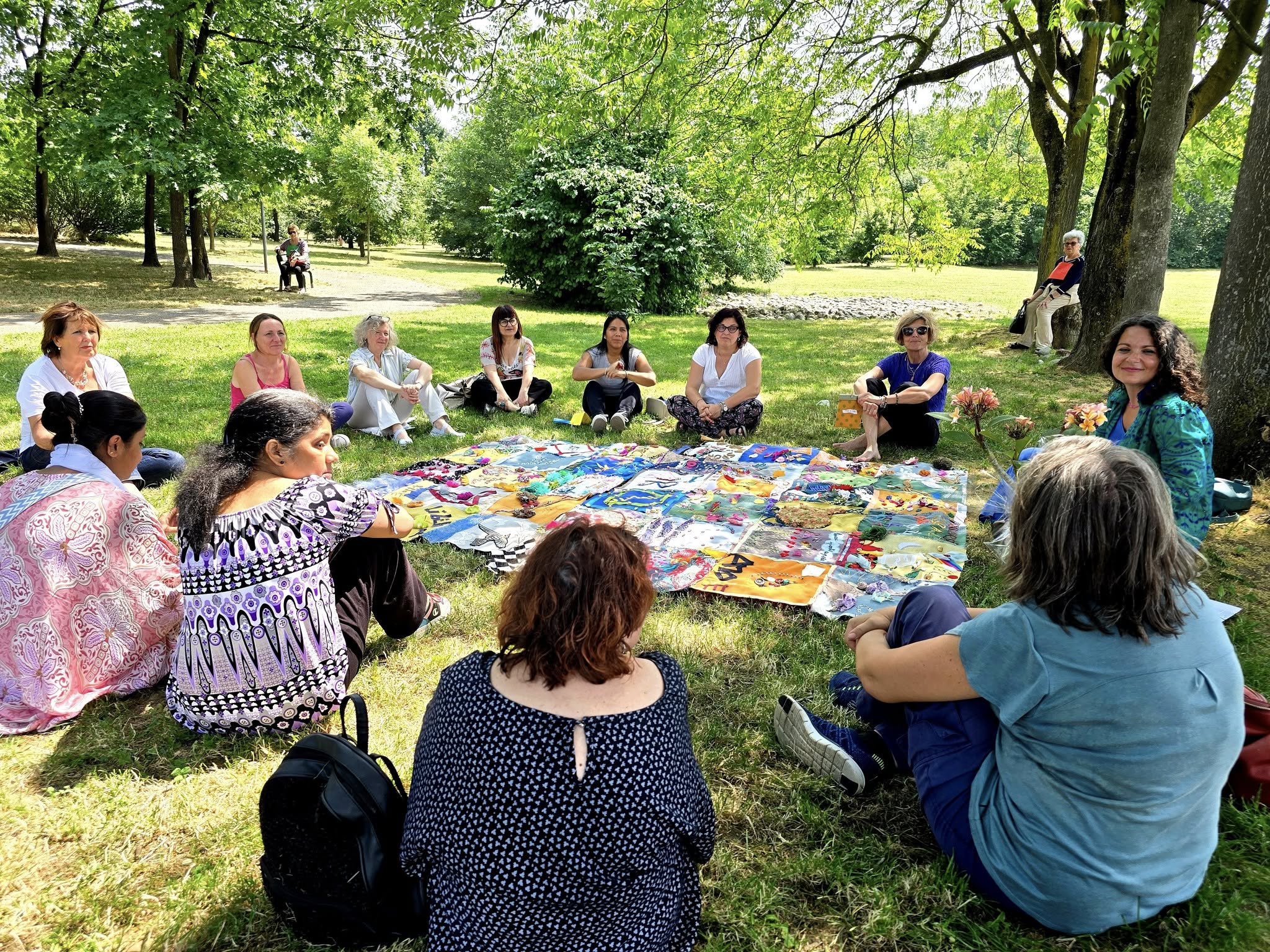GINKGO Project: CEFAL's testing with art therapy workshop

October 2025
As part of the testing phase of training module 8 - Networking and community
involvement, CEFAL Emilia Romagna, in collaboration with ASC InSieme (member of the GINKGO CTL), ran a workshop between March and June 2025 that used art therapy as a tool for community involvement.
The initiative was met with great enthusiasm by all those who participated, and concluded with the “TrAmare Comunità” flash mob on Caregiver Day 2025 in Casalecchio di Reno.
The experimentation was made possible thanks to the contribution of the professionals who participated, bringing their experience and putting their values of relationship and community into play.
Cecilia Baldini, consultant for ASC InSieme on caregiving projects, has been working for over twenty years in the Reno Lavino Samoggia district, where she supports elderly people and their caregivers.
Camilla Urso, a Gestalt-oriented art therapist, works between Umbria and Bologna,
conducting individual and group courses that combine art, care, and relationships.
We asked both of them to recount their experiences with the GINKGO project, reflecting on the results of the experiment and the concrete actions that can be taken to prevent the isolation of elderly people.
Interview with Cecilia Baldini
Can you briefly tell us who you are and what you do?
My name is Cecilia Baldini and since 2003 I have been working with ASC InSieme,
which manages social services in the Reno Lavino Samoggia district. I am particularly
involved in projects related to caregiving, from training family assistants to providing
support services to caregivers, with the aim of promoting home care and improving the quality of care.
What is the situation in your area with regard to the elderly population and the risk of social isolation ?
The district comprises five municipalities—Casalecchio di Reno, Monte San Pietro, Sasso Marconi, Valsamoggia, and Zola Predosa—with over 110,000 inhabitants. The elderly population represents a significant proportion: in Casalecchio, over 65s account for more than 26% of the population, and in Zola Predosa, the old-age index is almost 200 elderly people for every 100 young people. It is therefore a rapidly aging community where the risk of social isolation is real, especially for those who live alone or with limited family networks. Alongside this fragility emerges the figure of the family caregiver, often invisible but essential, who may in turn experience emotional strain and loneliness. This is why it is essential to offer spaces for listening and socialization also for those who provide care, so as to support not only the fragile person but the entire family and community system.
What strategies does your service introduce to combat isolation and promote the well-being of caregivers ?
The policies of the European Union and the Emilia-Romagna Region have long recognized the vulnerability of the elderly population and the need to strengthen local services. The District operates day centers, residential homes, home care services, transportation, and meal services, as well as counseling centers, self-help groups, and training courses for caregivers. Since 2017, thanks to the regional law on the recognition of family caregivers, we have been able to consolidate an integrated support network between social, health, and socio-health services. The objective is twofold: to lighten the burden of care and to strengthen the well-being of the caregiver, preventing crisis situations.
What strategies could be used to involve the community/citizens in preventing and combating social isolation among older people?
The Ginkgo Guide, which brings together tools and best practices for combating isolation, has been very useful for me in thinking about new strategies and services that are more participatory and community-based.
The key words are proximity, neighborhood, intergenerationality, training, and
listening.
Among the strategies I have identified, I would like to highlight :
· promoting active neighborhood networks, encouraging groups of citizens (“attentive
neighbors”) to maintain regular contact with lonely elderly people;
· creating “neighborhood agreements” with municipalities, associations, and citizens,
promoting volunteering and involving young people, retirees, and associations in
activities such as companionship, accompaniment, and entertainment;
· offering training for volunteers on listening and relationships;
· enhancing accessible and inclusive spaces—social centers, libraries, community
homes—enriching them with intergenerational activities;
· supporting intergenerational initiatives (activities between schools and older people, co- housing, etc.);
· developing awareness and information campaigns on the issue of isolation;
· sharing positive stories of involvement;
· integrating social and health services with the community;
· creating ‘light’ help desks in popular places (markets, pharmacies, parishes);
· practicing widespread listening, even outside formal channels, to bring out the needs of communities.
Interview with Camilla Urso
Can you introduce yourself and tell us how you came to work with GINKGO ?
My name is Camilla Urso, I am a Gestalt-oriented art therapist and I work between
Umbria and Bologna. I lead individual and group courses using different artistic media – from textiles to photography, from natural materials to colors. In recent years, I have
devoted myself in particular to community art therapy, a practice that combines
creativity, relationships, and social participation. I participated in GINKGO to create a
workshop for caregivers and operators, experimenting with how art can be a valuable
resource against isolation and the fatigue of caregiving.
What is art therapy and what value can it bring in this context?
Art therapy is a helping relationship that uses the creative process as a path to self-
knowledge and self-care. It is not the artistic product that counts, but the journey taken while creating: an expressive and transformative experience that promotes awareness, vitality, and the joy of being. Through shapes, colors, and materials, personal resources are reactivated and one rediscovers their ability to communicate and share, even when words are not enough. It is a practice that can bring both individual and collective well-being, helping people to regain confidence and connection.
How can it be helpful in counteracting the isolation of elderly people?
We live in a paradoxically hyperconnected but lonely society. Elderly people, in particular, are at risk of losing contact and relational stimuli. Art therapy, especially in groups, offers a welcoming and non-judgmental space where people can express themselves freely, give shape to their emotions, and rediscover the pleasure of creating. This promotes self-esteem, memory, attention, and motor skills, but above all, it allows people to rebuild human bonds and trust. Through artistic expression and exchange, distances are reduced and the social fabric is mended.
And how can it support operators, caregivers, and family assistants?
Care work is intensely relational and can be exhausting. Art therapy offers a time to “take care of the caregiver,” creating a space for personal regeneration. Through images, colors, and materials, it is possible to express difficult experiences, recognize one's own fatigue, and rediscover meaning in one's role. This helps to prevent burnout and rediscover the creative and vital dimension of one's work. Furthermore, within the group, the shared experience generates mutual support and recognition, which are essential elements for those who work in the helping relationship.
Can you tell us about your experience with the GINKGO experimental workshop?
The workshop took place over six biweekly sessions, each lasting three hours. Each
participant created a personal textile work (50x50 cm), which was then sewn together with the others to form a single large collective work. We gathered around a table set with fabrics, threads, and colors: we began by sharing words or personal stories, then moved on to free creation, and finally to sharing the works. The result was an intense experience of connection and mutual listening. The collective work represents a “community self-portrait”: a sign of each person's contact with themselves and with others. It is a concrete way to feel part of something bigger.
How can this kind of workshop become a way to build a community/collective
support network for elderly people and families?
In a time marked by fragmentation and loneliness, there is an urgent need to create
places for authentic encounters.
The community art therapy workshop can be this space: a library, a club, a square, or a neighborhood house that becomes a place of welcome and connection. Here, people of different ages, backgrounds, and vulnerabilities can meet, share their stories, and create together. Through art, meaningful relationships are built, the social fabric is regenerated, and personal and collective health is produced. Sitting around a table, sharing a color, a laugh, or a story, leads us to discover that we are not alone. As one participant from Morocco said:
“A house where no one knocks on the door is a tomb for those who live there.”
With art therapy and projects such as GINKGO, we are learning once again to knock on other people's doors, to return to living our lives together.



